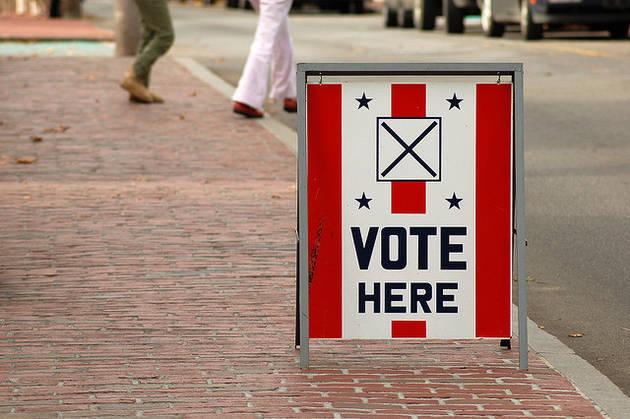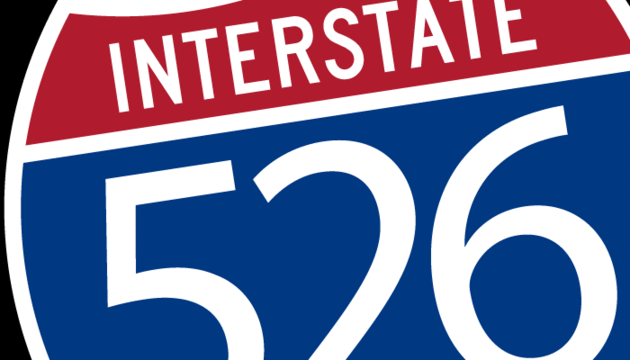
Flickr user Elvis Pepin
It looks like South Carolina's roads are set to stay free of speed-ticket cameras.
As required by the mid-2011 law that largely banned traffic cameras in South Carolina and dismantled Ridgeland's public-private traffic surveillance and ticketing system, the South Carolina Traffic Camera Enforcement Commission has published a recommendation, and it says that the state should uphold its ban.
The commission opens the report by writing, "At the heart of the Commission’s determination is the belief that traffic enforcement cameras are not in the best interest of South Carolinians."
And goes further saying, that the "Department of Public Safety should be solely authorized to operate" any camera enforcement system.
But while the report generally frowns on speeding related cameras, it is more tentative on the use of cameras to catch red light runners and stop sign skippers, writing, "The Commission concedes that there may be differences between using a camera system to enforce traffic laws related to speed limits and traffic laws regarding obedience to traffic control signals and stop signs. For example, it may be more readily apparent when a motorist disregards a stop sign or stop light."
Below are the full "findings" section of the report, and you can see the whole document over here.
The Commission submits the following in response to the issues concerning the use of traffic enforcement cameras to detect traffic regulation violations pursuant to item (3):
(A) The positives and negatives of a private company's involvement in enforcing traffic laws
Assuming that a private company is involved in enforcing traffic laws, a positive factor to consider is that a private vendor naturally would be most familiar with the traffic camera technology it provided to law enforcement personnel.
On the other hand, private companies because of financial incentives may be overly aggressive in enforcing these laws.
(B) Assuming private companies are authorized to participate in enforcing traffic laws, what would be the appropriate distribution of authority between law enforcement and a private company?
Assuming that private companies are authorized to participate in enforcing traffic laws, the Commission believes that only law enforcement personnel should issue traffic citations. The private company’s role should be limited to providing technical assistance.
(C) Is there a conflict of interest when a private company is paid a commission based on the number of traffic tickets issued through the use of its traffic enforcement camera systems? If so, how could the conflict of interest be resolved?
When a private company is paid a commission based on the number of traffic tickets issued, there is a clear inducement to issue as many tickets as possible. Therefore, conflicts of interest seem likely.
To resolve conflicts, a flat fee for service -- rather than a commission -- could be used. Alternately, a commission based on some other factor, such as a reduction in the number of vehicle accidents, could be considered.
There also should be full disclosure of traffic citation statistics, including, but not limited to the number of citations issued, fees and fines collected, and relevant safety statistics. The data should then be compared with data from similar roadways that have camera systems, and similar roadways that do not. Finally, the camera programs should regularly be reviewed by the appropriate governing body, and the public should be given regular opportunities to comment on the efficacy of the systems.
(D) What are the public policy implications, if any, of a private company reimbursing a state or local government for the use of their law enforcement personnel in connection with the operation of the company's traffic enforcement camera system?
The Commission has concerns about the public policy implications of a private company reimbursing state or local government for the use of their law enforcement personnel. Among the most serious concerns is the potential for financial improprieties. Traffic enforcement could become driven by the desire to fill government coffers -- and those of the private vendor -- rather than driven by public safety.
(E) Assuming that traffic enforcement camera systems are used to enforce uniform traffic laws, determine whether a statewide agency such as the Department of Public Safety should be solely authorized to operate the system, whether a statewide agency should operate the system in conjunction with local law enforcement authorities, or whether local law enforcement authorities be solely authorized to operate systems within their jurisdiction.
Assuming that traffic enforcement camera systems are used to enforce uniform traffic laws, the Commission believes that, ideally, a statewide agency such as the Department of Public Safety should be solely authorized to operate the system. At a minimum, DPS should set system guidelines and monitor camera programs, and should be authorized to take over or shut down programs when improprieties are found.
(F) What is the accuracy of current traffic enforcement camera systems, specifically whether vehicles violating the speed limit or failing to obey traffic control signals or stop signs, other than the vehicle photographed, trigger the photograph being taken and, if so, whether the technology can be improved to prevent that from occurring?
The Commission concedes that, properly calibrated and properly operated, photo radar systems may be accurate. However, photo radar, like any radar, can generate false readings, and similar cases are contested and litigated all the time. While technological improvements are likely, the system will never be completely without flaws.
(G) Determine whether it is important to have a law enforcement officer actually view the vehicle violating a speed limit in order to confirm, with his visual estimation of speed, what the radar indicates, whether an officer viewing a picture being taken of the vehicle is sufficient confirmation, or whether officer confirmation is necessary.
If traffic enforcement camera systems are used to enforce uniform traffic laws, the Commission believes it is crucial to have a law enforcement officer actually view the driver violating a speed limit in order to confirm, with a visual estimation of speed, what the radar indicates. The visual estimation should be contemporaneous with the radar reading and photo record.
The Commission notes that contemporaneous visual estimation and driver identification are additional issues that may open governing bodies to litigation. No matter who was driving the car at the time, the owner of the car is assumed to be guilty. This violates a major tenet of our legal system: innocent until proven guilty.
Additionally, there is no certifiable witness to the alleged violation. There is no ability to preserve evidence such as a GPS record of your speed at the time because the driver is unaware he or she has been ticketed. Furthermore, the Sixth Amendment ensures the right to face your accuser. With a camera violation, there is no accuser to confront or question. Even if there is an officer overseeing the operation, it is unlikely he or she will remember the events of that particular day and even less likely that he or she will remember a specific, alleged violation. The driver is similarly disadvantaged, particularly when significant time has passed since the alleged violation.
(H) Do traffic enforcement camera systems present a possible visual disturbance for the driver resulting from a flash when the system takes a picture?
The Commission has reason to believe that traffic enforcement camera systems do present a visual disturbance for the driver resulting from a flash when the system takes a picture. For example, witnesses submitted to the Senate Transportation Committee the following accounts concerning one South Carolina municipality’s speed camera system: “This town police (vehicle) is flashing photographs with a strobe light which is not only disruptive but dangerous to traffic.” Another stated that “I was blinded by an intense flash as I passed by.” Another stated “I was the unfortunate recipient of one of these blinding flashes...” At least two drivers also reported nearly having accidents as a result of these flashes.
(I) Does the use of traffic enforcement camera systems diminish the dangers to and increase the safety of law enforcement personnel?
Ticket cameras have not been shown definitively to improve safety. While some evidence shows that safety is improved, there is other evidence that suggests cameras result in “bunching”, whereby drivers brake when they see a speed camera, thus disrupting the flow of traffic. The cameras may also present the danger noted in item (h). For these reasons, the Commission is wary of the possibility that speed cameras could cause vehicular speed differentials and result in traffic congestion. Safety studies indicate that there is a direct correlation between traffic flow (congestion) and accidents.
(J) Does the use of traffic enforcement camera systems decrease the number of speed limit violations and, thereby, increase public safety?
See (i) above.
(K) Does the use of traffic enforcement camera systems in connection with law enforcement raise any personal privacy issues?
If a ticket is mailed to a home occupying more than one licensed driver, there is no guarantee that the ticket will be received by the intended individual, thus violating their right to privacy. There is no right to privacy on public roads.
(L) Identify the criminal laws, if any, that should not be enforced by cameras.
The Commission finds this question to be outside its scope of expertise. The matter may need to be studied in a broader context.
(M) Determine the information contained in photographs taken by traffic enforcement camera systems should be limited to the enforcement of traffic laws, or whether the information, including, but not limited to, license plate numbers, should also be generally available for use by law enforcement for official law enforcement purposes.
If traffic enforcement camera systems are used to enforce uniform traffic laws, the Commission believes that the information contained in photographs should be limited to the enforcement of traffic laws.
(N) Is there a difference between using a traffic enforcement camera system to enforce traffic laws related to speed limits and traffic laws requiring obedience to traffic control signals and stop signs?
The Commission concedes that there may be differences between using a camera system to enforce traffic laws related to speed limits and traffic laws regarding obedience to traffic control signals and stop signs. For example, it may be more readily apparent when a motorist disregards a stop sign or stop light.
(O) Assuming that traffic enforcement camera systems are used to enforce uniform traffic laws, should they be used on all public roads, only on certain roads, or only in certain areas, including, but not limited to, school zones, temporary work zones, and construction zones?
Assuming that traffic enforcement camera systems are used to enforce uniform traffic laws, the Commission believes that the use of camera systems should be limited to certain areas, possibly including school zones, temporary work zones, and construction zones. The use of camera systems on all public roads would not be in the best interest of the people of South Carolina.
(P) Assuming that traffic enforcement camera systems are used to enforce uniform traffic laws, is there a way to ensure that traffic enforcement camera systems are being used to improve road safety, and assuming that their use improves road safety, rather than maximizing government revenues resulting from violations of uniform traffic laws?
Assuming that traffic enforcement camera systems are used to enforce uniform traffic laws, the Commission believes that determining a direct correlation between the use of camera system and improvements in road safety could be difficult. The Commission notes that there are many factors that contribute to road safety, such as traffic volume, vehicle speed differentials, pavement quality, road width, and signage.
(Q) What is the constitutionality of utilizing traffic enforcement camera systems to enforce uniform traffic laws and mailing citations to alleged violators? If unconstitutional, what is the manner in which a system may be constitutionally operated?
The South Carolina Attorney General’s office noted on October 31, 2001 that:
The general case law and other authority reviewed herein supports the conclusion that a properly drafted statute authorizing use of photo-radar or similar forms of automated traffic enforcement would pass constitutional muster. These authorities have reviewed automated traffic enforcement from a variety of constitutional perspectives including the Due Process and Equal Protection Clauses, the Fourth Amendment’s protection against unreasonable searches and seizures, the Sixth Amendment’s right to present an adequate defense as well as the federal and state constitution’s right to privacy. The general consensus is that automated traffic enforcement is constitutional.
Of course, constitutionality of any statute authorizing automated traffic enforcement would depend, in part, upon a well drafted statute. ...this form of traffic enforcement is already extant in a number of jurisdictions so that one or more of these statutes might be used as a guide or model. I would also caution that the South Carolina Constitution contains an express provision protecting privacy in Art. I, §10, and any statute authorizing photo-radar or a similar form of enforcement would have to be drafted with this provision in mind. That having been said, it is clear that some form of statutory enactment, as opposed to constitutional amendment, would suffice.
(R) What are the public policy implications, if any, raised by citations for uniform traffic law violations being mailed to the alleged violator after the event as opposed to being personally delivered contemporaneous with, or within one hour of, the alleged violation?
The Commission believes that a number of serious public policy implications may be raised by mailing traffic citations. South Carolina law specifically prohibits the delivery of citations by mail. Delivery by mail does not ensure that the accused will receive the citation. However, because there is an assumption on the part of the court that a citation has been received, if a ticket is left unpaid, the court presumes the driver purposefully refused to pay. A warrant then may be issued for the accused person’s arrest. Because an accused driver may not receive the citation until days or weeks after the alleged violation, the driver may have difficulty filing an appeal and preparing a defense in a timely manner.
There are cases where local courts have dismissed challenged tickets after an accused driver questioned the legality or definitude of an automatically-generated camera citation. Because local governments seem to be uncertain of their legal footing, local courts have dismissed these contested cases, and, therefore, the question is never fully adjudicated. The Senate Transportation Committee has been advised of such cases by several accused drivers.
The Commission also notes that, regarding speed camera violations in particular, the accused party likely has precious little evidence with which to present a defense to a camera citation. Given the sheer number of citations generated by automated photo radar, even with an officer overseeing the camera operation it is unlikely that the officer will later remember the circumstances surrounding a specific driver on a particular day. The driver is also disadvantaged because the driver’s recall of events naturally diminishes over time. Because the officer has not stopped a driver and has not personally delivered a citation contemporaneous with the alleged violation, the driver is likely unaware that he has been automatically ticketed. Therefore the driver would have no reason to remember, much less preserve, evidence at the time of the alleged violation.
(S) Does state's criminal justice system currently have a sufficient number of judges and magistrates to handle the increased number of citations that would result from statewide use of traffic enforcement camera systems?
The Commission has reason to believe that the state's criminal justice system currently does not have a sufficient number of judges and magistrates to handle the increased number of citations that would result from statewide use of traffic enforcement camera systems. Already backlogged courts likely would become even more burdened due to the high volume of automatically- generated speed camera citations. Local governments may have to spend additional tax dollars to expand traffic court systems, and the state may have similar needs at the circuit level due to appeals.
(T) Assuming that traffic enforcement camera systems are used to enforce uniform traffic laws, what is the manner in which the revenue raised should be allocated and the purposes for which it should be used?
Assuming that traffic enforcement camera systems are used to enforce uniform traffic laws, the revenue raised should be allocated using the same formula as is used to distribute revenue from traditional traffic citations.
Pursuant to item (4) Commission recommends no changes to the existing law concerning the use of traffic enforcement camera systems.


